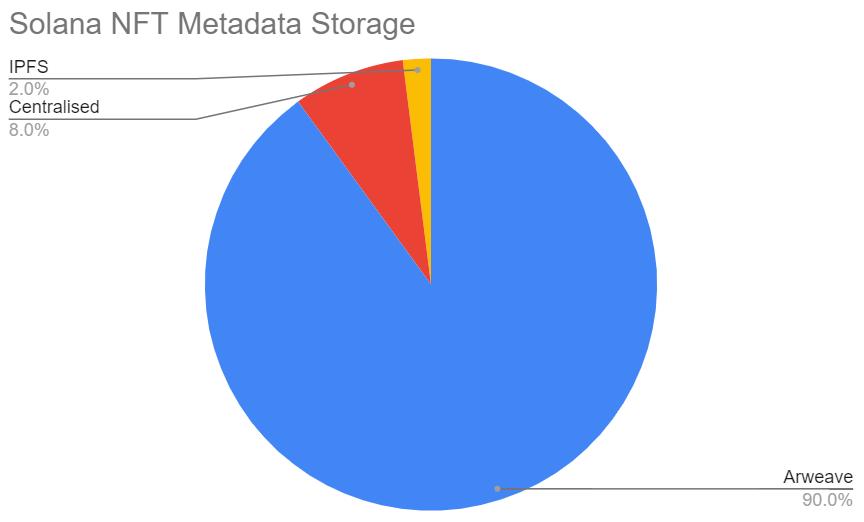A Brief Analysis of the Advantages and Disadvantages of Different NFT Data Storage Methods and Future Prospects
Author: Captain Hiro
Over the past year, creators have sold digital art, collectibles, and gaming projects to their true fans using NFTs (non-fungible tokens), earning billions of dollars in total. NFTs are tokens that represent ownership of unique assets on the blockchain. Each NFT project has a blockchain-based smart contract that tracks who owns what asset.
At the core of each NFT is its metadata. This metadata includes a description of the NFT (name, attributes, properties, etc.) and pointers to its media files (images, videos, audio, etc.).
Storing this information directly on the blockchain is very expensive, so most NFT projects store their data elsewhere and only keep a storage link in their smart contracts.
 Example of a common NFT data structure
Example of a common NFT data structure
In this piece, I will cover:
- An overview of the advantages and disadvantages of different NFT data storage methods
- An investigation into the adoption levels of each data storage method
- A discussion on the future of NFT data storage
Storage Methods
Centralized Storage
The worst choice for storing NFT data is on a centralized server. If an NFT project's metadata and media files are stored on a server and the creator stops maintaining that server, the data will disappear forever, ultimately rendering the NFT "blank." The person controlling the server can also change the NFT's description and content at any time without the owner's permission. This completely undermines the purpose of NFTs. If your asset can be seized, altered, or censored, then you do not have true ownership of it.
Using a decentralized file storage solution is key to preventing seizure, alteration, and censorship. The two most popular decentralized solutions for storing NFT data are InterPlanetary File System (IPFS) and Arweave.
IPFS
IPFS is a peer-to-peer file storage network. A computer known as a node stores files uploaded to the network and uses a unique hash value to identify these files. The biggest difference between IPFS and web-based file storage is that IPFS uses a content-based addressing system. When a file request is made, the network uses the file's hash value to find a node that holds that file and provides it to the requester. 

The weakness of IPFS is that it cannot guarantee the persistence of file storage. This means that data uploaded to IPFS will not remain there permanently. As long as at least one node in the network is storing the content and making it available, the file will exist on IPFS, which is also referred to as "pinning."
To store files on IPFS long-term, many NFT projects and marketplaces either manually pin their data or use pinning services to ensure that at least one IPFS node always holds a copy. If the project or platform maintaining the IPFS data for the NFT fails and stops pinning the files, all stored information will be lost over time as nodes holding copies clear their memory caches or go offline.
Arweave
Arweave is a decentralized file storage network that guarantees the persistence of file storage. Users pay a one-time fee to cover 200 years of storage costs. The 200-year benchmark is an extremely conservative estimate, as the price of physical data storage will continue to decline in the future. If the cost decreases faster than estimated, the storage time for Arweave files will far exceed 200 years.
Computers in the Arweave network are called miners, who are incentivized to use AR tokens to replicate and store copies of data that other miners store infrequently. This ensures that files do not get lost over time without the need for ongoing maintenance from the original uploader.
Arweave stores data in a structure called blockweave. Each new data block is linked to the previous block and a historical block. Miners must prove that they have had the opportunity to access these randomly selected historical blocks in order to mine new blocks and earn rewards, ensuring that earlier blocks are preserved.

Blockweave
On-Chain
Using IPFS or Arweave is much better than relying on centralized storage, but it still requires off-chain pointers. Storing NFT metadata and media on the same chain as the NFT is the most resilient method, but the cost of on-chain data storage is high. NFT projects that keep data on-chain utilize a variety of compression techniques to reduce this cost.
Current NFT Storage Adoption on Major Public Chains
Ethereum
On Ethereum, IPFS is the most popular medium for NFT metadata storage. Among the top 100 NFT contracts ranked by transaction volume, 48% of contracts store their metadata on IPFS. Unfortunately, centralized servers are the second most common choice for NFT metadata storage on Ethereum.
Additionally, it is worth noting that among the top projects storing metadata on IPFS, 20% use dedicated gateway links from Pinata in their contracts instead of the default IPFS links. Pinata is one of the most popular IPFS pinning and data management services. If Pinata were to shut down one day, these links would break, and the corresponding NFTs would become blank.

Top 100 Ethereum Metadata Storage

Top 100 Ethereum Collectibles Media File Storage
In the sample group, 31% of projects used centralized servers to store metadata while storing their media files on IPFS or Arweave. While this is better than storing everything on private servers, it does not reduce the risk for collectors. Essentially, if the metadata is compromised, the media files will also be lost.
Solana
Arweave is the primary NFT data storage option on Solana, with 90% of top trading projects using it to preserve metadata. The guarantee of persistence and the lack of maintenance requirements make Arweave an attractive choice for projects in the newer ecosystem, where IPFS does not hold as much market share. Additionally, some of the most popular toolkits for minting Solana NFTs, such as Metaplex, use Arweave as the default storage method.

Top 50 Solana Collectibles Metadata Storage

Top 50 Solana Collectibles Media File Storage
Polygon
The Polygon NFT ecosystem has a high risk of centralization. 61% of top trading projects rely on private servers for metadata storage.

Top 100 Polygon Metadata Storage

Top 100 Polygon Collectibles Media File Storage
How Should I Store Data for My NFT Project?
Storing your NFT metadata and media on-chain ensures that the data is preserved for as long as the underlying blockchain exists. Strong implementations you can reference include Uniswap V3 NFT, Blitmaps, and NounsDAO. However, storing large media assets on-chain can be very expensive, so this method is not always very practical.
The best storage option for most NFT projects is Arweave. If you have programming skills, you can use Bundlr CLI to upload your NFT data to Arweave. If you are not technically inclined, the ArDrive web application provides a no-code solution for uploading files to Arweave. In the Ethereum ecosystem, you can use the Manifold platform to easily create and deploy NFT contracts with Arweave data storage. On Solana, Metaplex provides a toolkit for minting NFTs with Arweave data storage.
IPFS is the next best option. There are numerous platforms and developer tools available for managing IPFS storage, including NFT.Storage, Pinata, and IPFS CLI. Thirdweb offers a no-code dashboard and a developer toolkit for creating NFT projects with IPFS data storage across multiple chains.
You should not use centralized servers for long-term storage of metadata and media. This option carries the highest risk of data loss and corruption.
The Future of NFT Media Storage
- I predict that we will see many high-value NFT collectibles' media files become corrupted or lost forever. Sooner or later, a project with a high floor price and centralized storage will collapse. The team maintaining the server will either stop paying their server fees or forget to update the domain ownership for the metadata that the NFT contract points to.
- Events like this will raise awareness of the fragility of the NFT data storage environment, and serious NFT collectors will avoid projects that do not use decentralized data storage.
- More NFT projects and platforms that rely on centralized data storage will transition to decentralized options to ensure their longevity. This process typically involves the following:
- Uploading the project's data to IPFS or Arweave
- Allowing the creators of the NFT contracts to reset the links to the metadata.
- Destroying the keys to the contract creator's wallet to ensure that no one has the ability to change this link in the future.
Open Questions
The current state of NFT media storage is far riskier than most collectors realize. The field is still in a very early stage, and there is much work to be done. Specific areas that need progress include:
- NFT marketplaces and applications disclosing the storage location information for NFT metadata and media assets so that risk-aware holders can make informed decisions.
- New platforms enabling owners of high-value assets to easily check the health of their IPFS-dependent NFTs, lock in their NFT data, and recover that data in case of loss.
- Improving the user experience of infrastructure for using decentralized storage NFT platforms. For example, Bundlr helps platforms store their data on Arweave more efficiently and allows them to pay with their native tokens instead of using AR tokens.











